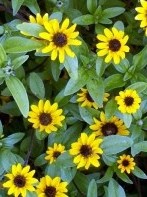 When you see this plant for the first time covered with flowers you can’t help wonder how it ever got the name “zinnia”. Creeping is understandable, as it is very low growing and forms a nice dense mass of leaves and flowers, but the flowers look a lot more like Black-eyed Susan’s than zinnias. The flowers of creeping zinnia are much smaller than those of black-eyed Susan’s but the golden yellow ray flowers around a dark disc have the same simple charm. The flowers of creeping zinnia are borne in abundance on trailing hairy stems and are set off by a pair of leafy bracts growing beneath them. The plants do well as an edging at the front of a border or in containers, and cut stems will last in a vase for several days. This is a nice heirloom plant to include in any garden.
When you see this plant for the first time covered with flowers you can’t help wonder how it ever got the name “zinnia”. Creeping is understandable, as it is very low growing and forms a nice dense mass of leaves and flowers, but the flowers look a lot more like Black-eyed Susan’s than zinnias. The flowers of creeping zinnia are much smaller than those of black-eyed Susan’s but the golden yellow ray flowers around a dark disc have the same simple charm. The flowers of creeping zinnia are borne in abundance on trailing hairy stems and are set off by a pair of leafy bracts growing beneath them. The plants do well as an edging at the front of a border or in containers, and cut stems will last in a vase for several days. This is a nice heirloom plant to include in any garden.
Sanvitalia procumbens was introduced into England from Mexico in 1798 and was named after Federico Sanvitali, an Italian professor, author, and naturalist. The plant did not stir up much excitement at the time but did not go unnoticed and was selected by such famous gardeners as Gertrude Jekyll for a place in her garden. It is easy to grow, slows down during times of high temperatures and humidity, but comes back full force as the days cool down in the fall. No need to dead head as plants are self-cleaning.
Type: Annual
Bloom: An abundance of 1” wide golden yellow, orange or white flowers with a dark central disc are borne from summer into fall.
Foliage: Dark green lanceolate leaves
Size: 4-8” H x 12-16” W
Light: Full sun, partial shade in South
Soil: Light, well drained.
Care: Low maintenance; water during times of drought as plants may stop blooming if soil dries out.
Fertilizer: Apply complete fertilizer at planting time and every 6 weeks after that.
Pests and Diseases: None of significance
Propagation: Seed
Companion plants: Blue salvia, marigolds, blue verbena, lirope
Outstanding Selections:
‘Golden Braid’ (golden double flowers with brown center)
‘Mandarin Orange’ (bright orange single flowers with black center)
